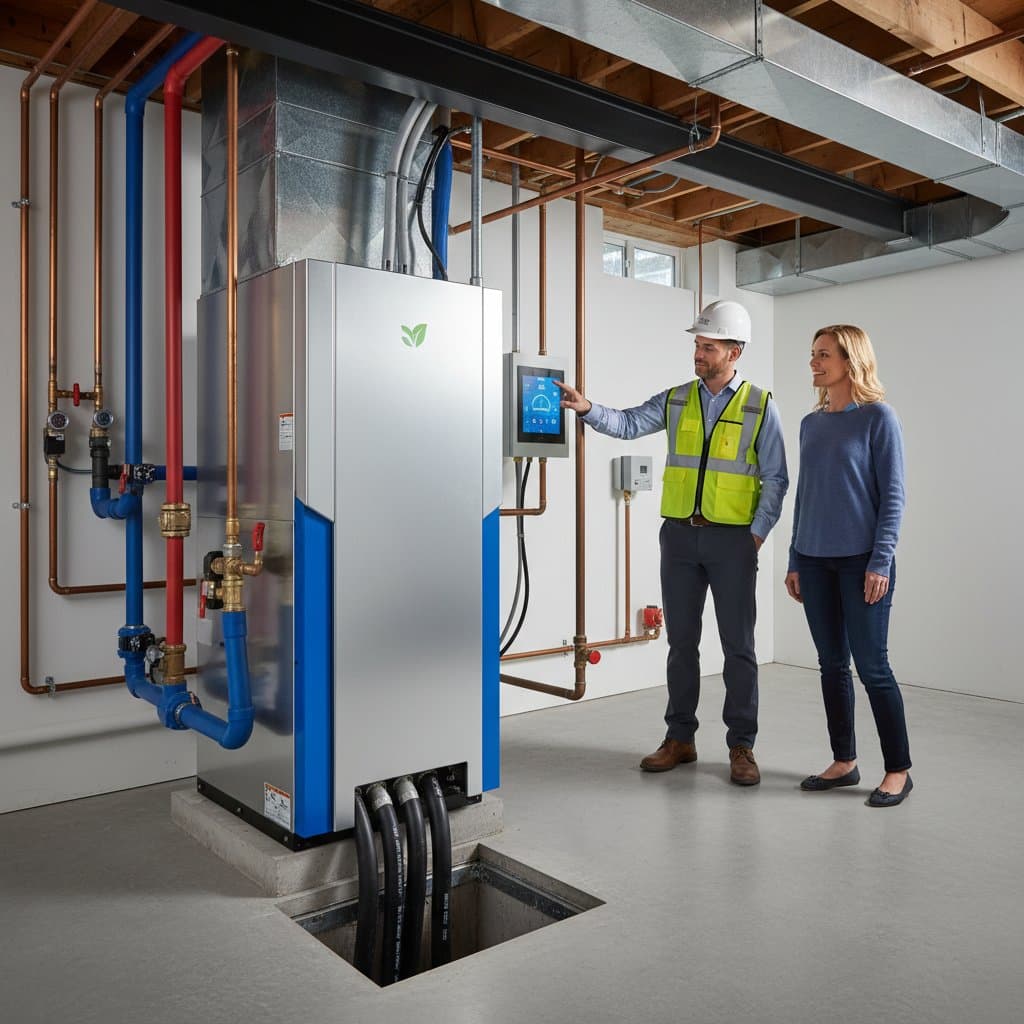Key Benefits of Geothermal Systems
- Geothermal systems utilize stable underground temperatures for superior energy efficiency and significant cost reductions.
- Owners realize long-term gains via lower utility expenses, reduced upkeep, and elevated property appraisals.
- Optimal performance demands accurate sizing, soil analysis, and expert installation.
- Diverse financing and rebate programs render geothermal accessible for various budgets.
The Steady Power Underfoot
Picture a winter evening in your living room, where a geothermal system silently draws warmth from the earth to heat your space. No roaring furnace interrupts the peace, no fuel trucks arrive unannounced, and energy bills remain steady. In summer, the system inverts its operation to expel indoor heat into the ground, relying on temperatures that fluctuate little just below the surface.
This unobtrusive efficiency redefines residential energy use. With utility prices climbing and environmental concerns mounting, sustainable options that blend reliability with fiscal prudence gain traction. Geothermal technology, previously considered specialized, now stands as a prudent choice for new builds and renovations alike.
Financial and Ecological Advantages
Geothermal heating and cooling employs a ground-source heat pump to exchange thermal energy between the home and soil. The earth's consistent temperature allows the system to cooperate with natural conditions. Consequently, efficiency can surpass 400 percent, delivering four units of heat or cooling per unit of electricity consumed.
Such performance yields direct savings. Based on regional rates and home dimensions, annual heating and cooling expenses drop by 30 to 70 percent. Over the system's lifespan, which spans over 20 years for the heat pump and 50 years for the ground loop, cumulative savings often total tens of thousands of dollars.
On the environmental front, advantages prove substantial. The system generates no on-site emissions from burning fuels. By sourcing most energy from the ground, it eases pressure on electrical grids and supports a reduced-carbon energy landscape.
Operational Mechanics
A geothermal setup comprises three primary elements: the ground loop, heat pump, and distribution network.
- Ground Loop: Buried pipes circulate a fluid mixture that captures or dissipates heat from the earth.
- Heat Pump: Positioned indoors, this unit moves heat between the loop and the home's air or water circuits.
- Distribution System: Ducts or in-floor pipes convey treated air or warmth to occupied areas.
In winter, loop fluid extracts ground heat and delivers it to the pump for compression and dispersal indoors. Summer operation reverses this, extracting home heat for ground release. Though intricate in description, the design proves straightforward, with no weather-exposed outdoor units and scant maintenance relative to standard HVAC.
Investment Analysis: Costs Versus Payback
Upfront costs for geothermal installation exceed those of traditional furnaces or air conditioners. Estimates range from $15,000 to $40,000, influenced by system scale, ground type, and loop layout. However, ongoing expenses reveal a compelling case for investment.
Conventional HVAC endures about 15 years, whereas geothermal doubles that duration. Rebates, low-interest loans, and energy reductions shorten payback to five to ten years. Thereafter, heating and cooling approach zero marginal cost for the system's remainder.
As an asset, geothermal yields returns comparable to low-risk investments, while enhancing resale appeal. Prospective buyers increasingly prize efficient features that promise reduced bills and green credentials.
Site-Specific Design Factors
Selecting a geothermal configuration requires evaluating site attributes. Options include horizontal, vertical, pond, and open-loop designs.
- Horizontal Loops suit spacious lots with feasible trenching.
- Vertical Loops fit compact properties or rocky terrains amenable to drilling.
- Pond Loops exploit nearby water to minimize digging.
- Open-Loop Systems leverage groundwater but necessitate sustainable sourcing and disposal.
Soil type and hydration affect thermal exchange. Arid sands demand extended loops versus wet clays. Experts perform conductivity tests to tailor the setup precisely.
Retrofitting and New Builds
In existing homes, geothermal integrates with prevailing ducts or hydronic setups. Assessments of insulation, ventilation, and thermal loads confirm compatibility and sizing.
New constructions offer broader integration, such as radiant floors, zoning, and hot water generation via one unit. This approach optimizes performance and streamlines infrastructure.
In harsh climates, hybrid configurations pair geothermal with solar or auxiliary heaters for robustness. The aim: balanced efficiency that curbs costs and sustains comfort across seasons.
Indoor Health and Serenity
Geothermal fosters superior air quality. Absent combustion or storage risks, it avoids carbon monoxide hazards and curbs particulates. Steady dehumidification inhibits mold and eases breathing.
Operation remains whisper-quiet, free of external fans or igniters. Residents experience uniform temperatures, banishing the drafts or blasts of legacy systems.
Durability and Sustained Worth
Geothermal excels in endurance. Loops carry 50-year warranties, and indoor units outlast peers. Protected from elements and with few components, repairs stay infrequent.
This reliability bolsters economics. A single investment averts repeated replacements, locking in affordable climate control. It also buffers against energy volatility.
Broader resilience aids during outages or shortages, fortifying personal and communal stability.
Funding and Support Programs
Elevated initial outlays yield to accessible financing. Specialized loans align payments with bill reductions. Utilities and governments offer rebates; some providers lease units or guarantee output.
Focus on lifecycle economics, factoring savings and upkeep. Analyses often affirm geothermal's dual fiscal and ecological merits.
Homeowner Inquiries Addressed
What depths are required for loops? Vertical types descend hundreds of feet; horizontals sit four to six feet down. Targets: stable thermal zones.
Do they function in extreme weather? Affirmative. Ground constancy ensures efficacy; sizing handles peaks.
What upkeep applies? Monitor filters, fluids, and pressures; schedule yearly checks. Demands fall below traditional HVAC.
Does it boost resale value? Yes. Efficiency draws eco-conscious buyers, supporting premium pricing.
Can it supply hot water? Indeed. Desuperheaters redirect surplus for economical domestic use.
Next Steps for Geothermal Adoption
Initiate with a professional energy audit to gauge insulation, sealing, and current systems. This informs sizing and loop choices. Consult certified installers to map your path to efficient, enduring comfort.









